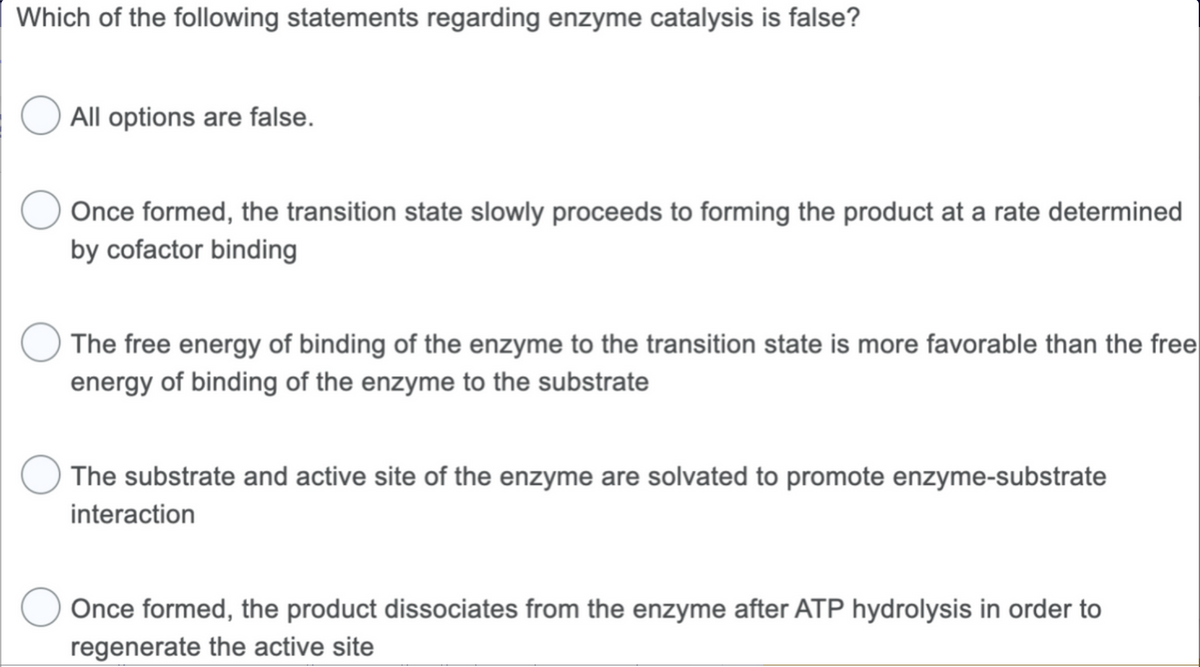Which of the following statements regarding enzyme catalysis is false? All options are false. Once formed, the transition state slowly proceeds to forming the product at a rate determined by cofactor binding The free energy of binding of the enzyme to the transition state is more favorable than the free energy of binding of the enzyme to the substrate The substrate and active site of the enzyme are solvated to promote enzyme-substrate interaction Once formed, the product dissociates from the enzyme after ATP hydrolysis in order to regenerate the active site
Which of the following statements regarding enzyme catalysis is false? All options are false. Once formed, the transition state slowly proceeds to forming the product at a rate determined by cofactor binding The free energy of binding of the enzyme to the transition state is more favorable than the free energy of binding of the enzyme to the substrate The substrate and active site of the enzyme are solvated to promote enzyme-substrate interaction Once formed, the product dissociates from the enzyme after ATP hydrolysis in order to regenerate the active site
Biochemistry
9th Edition
ISBN:9781319114671
Author:Lubert Stryer, Jeremy M. Berg, John L. Tymoczko, Gregory J. Gatto Jr.
Publisher:Lubert Stryer, Jeremy M. Berg, John L. Tymoczko, Gregory J. Gatto Jr.
Chapter1: Biochemistry: An Evolving Science
Section: Chapter Questions
Problem 1P
Related questions
Question
this is my fifth time submitting in bartelby and every single time I got a different answer. Please please please, make sure of ur answer

Transcribed Image Text:Which of the following statements regarding enzyme catalysis is false?
All options are false.
Once formed, the transition state slowly proceeds to forming the product at a rate determined
by cofactor binding
The free energy of binding of the enzyme to the transition state is more favorable than the free
energy of binding of the enzyme to the substrate
The substrate and active site of the enzyme are solvated to promote enzyme-substrate
interaction
Once formed, the product dissociates from the enzyme after ATP hydrolysis in order to
regenerate the active site
Expert Solution
This question has been solved!
Explore an expertly crafted, step-by-step solution for a thorough understanding of key concepts.
Step by step
Solved in 6 steps

Recommended textbooks for you

Biochemistry
Biochemistry
ISBN:
9781319114671
Author:
Lubert Stryer, Jeremy M. Berg, John L. Tymoczko, Gregory J. Gatto Jr.
Publisher:
W. H. Freeman

Lehninger Principles of Biochemistry
Biochemistry
ISBN:
9781464126116
Author:
David L. Nelson, Michael M. Cox
Publisher:
W. H. Freeman

Fundamentals of Biochemistry: Life at the Molecul…
Biochemistry
ISBN:
9781118918401
Author:
Donald Voet, Judith G. Voet, Charlotte W. Pratt
Publisher:
WILEY

Biochemistry
Biochemistry
ISBN:
9781319114671
Author:
Lubert Stryer, Jeremy M. Berg, John L. Tymoczko, Gregory J. Gatto Jr.
Publisher:
W. H. Freeman

Lehninger Principles of Biochemistry
Biochemistry
ISBN:
9781464126116
Author:
David L. Nelson, Michael M. Cox
Publisher:
W. H. Freeman

Fundamentals of Biochemistry: Life at the Molecul…
Biochemistry
ISBN:
9781118918401
Author:
Donald Voet, Judith G. Voet, Charlotte W. Pratt
Publisher:
WILEY

Biochemistry
Biochemistry
ISBN:
9781305961135
Author:
Mary K. Campbell, Shawn O. Farrell, Owen M. McDougal
Publisher:
Cengage Learning

Biochemistry
Biochemistry
ISBN:
9781305577206
Author:
Reginald H. Garrett, Charles M. Grisham
Publisher:
Cengage Learning

Fundamentals of General, Organic, and Biological …
Biochemistry
ISBN:
9780134015187
Author:
John E. McMurry, David S. Ballantine, Carl A. Hoeger, Virginia E. Peterson
Publisher:
PEARSON